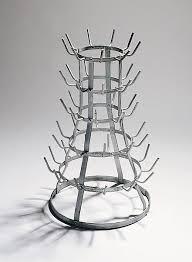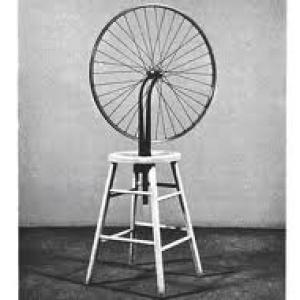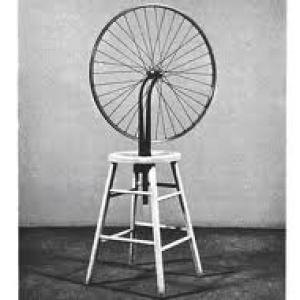CENTENNIAL OF READY-MADE. 1913-2013
A century ago, in the center of the modernist avant-garde of the ruptures, the French artist Marcel Duchamp (1887-1968), after passing through painting experiences and research on the representation of movement, simultaneity, of temporality and the functioning of the human body and the machines arrived in radical operation to promote a checkmate in orthodox concept of art work, understood as an object drawn by the artist's hands.
Apex of the questioning of Marcel Duchamp, founded in antiart and against the purely retinal Western art, ready-made was the denial of the work (according to traditional categories) and their replacement by appropriate industrial product, subtracted from its function, anonymous indifferent to personal taste, oblivious to the artistic styles, with no attractive or aesthetic value. The first ready-made, the Bicycle Wheel (1913), resulted from coupling objects with opposite functions: a bicycle wheel seated on a wooden bench, the door-Bottles (1914) was produced by direct appropriation of the object without even be changing its name; Fountain (1917), a title that received a piece of male health, is a urinal insinuating eroticism and abjection, signed by the pseudonym R.Mutt and lying on a base of sculpture; LHOOQ (1919) is a reproduction of the Mona Lisa by Leonardo da Vinci (1452-1519) on which Duchamp painted a mustache and goatee and gave a title obscene. The ready-made was loaded with iconoclasm and androgyny desmistificadoras of established, installed and definitely its paradox in the body of Art History to promote doubt about the concept of authorship, the question what is or is not art, to move the focus of the physical object to the concept.
Negativity and provocation of Duchamp pointed to the depletion of pictorial and research to overcome issues intrinsic to modernism, highlight the historic rules of the game art in the West, have revealed the roles of actors, operations and valuation of institutionalization, and mechanisms of the art circuit external to the object itself. The ready-made undisguised exposed the severity of the crisis at that time by the Western artistic paradigm. Marcel Duchamp stopped painting, withdrew from the official medium of art and became a chess player. Checkmate!
Visionary and pioneering major changes occurred during the second half of the 20th century and the early years of the 21st century, the ready-made waited for the closing of the cycle history of modernism and waited almost half a century to be absorbed. From 1960s, with the cultural transformations that arise within the consumer society of high capitalism, art movements that emerged finally understood the attitude of Duchamp and redid the standards of art in direct confrontation with reality, based on the appropriation of objects and industrial imaging, the use of everyday elements marked by technical reproducibility, in search of visual references in the languages R03;R03;of the means of mass communication. The Pop Art, New Realism and French New Brazilian Objectivity movements that were, each in his own way and within its respective context, deployed the concept of ready-made in addition to the original field of anti-art, and the gesture enxergaram grabber Marcel Duchamp opportunities to constitute a new field of artistic expansion.
The appropriation inaugurated a different way of making art, open and permeable to the flow of life, without claiming to be elevated above the viewer. Today, everything can be the object of the appropriation of artists / visual: objects, pictures, works of other authors, social situations, human bodies, technological devices, media messages and thoughts philosophical or anthropological, nothing escapes. The contemporary work produced through the appropriation insists on maintaining its presence full of strangeness, being in a sense close and recognizable to the world of the viewer, and another being an agent provocateur uncomfortable and destructuring of the principles of a material, symbolic, mental and behavioral governing that same world.
It is on the order of everyday language that appropriative act introducing deviations functional nature, plastic, conceptual, dilating the relationship fields of art cultured with the universe of banal objects and messages disposable made for a mass culture eager consumption. Then the appropriation works by extracting raw visual and conceptual, causing estrangement and disorder in orthodox paradigm of art, provoking the public questioning loaded with amazement: "but this is art?"
To present my reflections and promote several questions in the public mind about so many complex issues, the work is the starting point of many questions; chess pieces? pink, blue and black? Brightness? Cheese box? Wheel infant car?
I leave these questions to the jury and public ones.
Next part will put up a wall with pins for the public to respond to all questions that will install on the wall to the bottom part, which is connected to the wall of the exhibition space.
reflects on the appropriation in art carioca; Ge Orthof discusses the role of ownership in the process of creation in performance and installation; Yiftah Peled shows the relationship between scene ready-made and performance; Carlos Sena investigates modes of appropriation art present in Goiás.
Divine Sobral









Comments 4
Say something